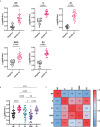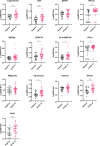Antibodies against Spike protein correlate with broad autoantigen recognition 8 months post SARS-CoV-2 exposure, and anti-calprotectin autoantibodies associated with better clinical outcomes
- PMID: 36032086
- PMCID: PMC9403331
- DOI: 10.3389/fimmu.2022.945021
Antibodies against Spike protein correlate with broad autoantigen recognition 8 months post SARS-CoV-2 exposure, and anti-calprotectin autoantibodies associated with better clinical outcomes
Abstract
Autoantibodies to multiple targets are found during acute COVID-19. Whether all, or some, persist after 6 months, and their correlation with sustained anti-SARS-CoV-2 immunity, is still controversial. Herein, we measured antibodies to multiple SARS-CoV-2 antigens (Wuhan-Hu-1 nucleoprotein (NP), whole spike (S), spike subunits (S1, S2 and receptor binding domain (RBD)) and Omicron spike) and 102 human proteins with known autoimmune associations, in plasma from healthcare workers 8 months post-exposure to SARS-CoV-2 (n=31 with confirmed COVID-19 disease and n=21 uninfected controls (PCR and anti-SARS-CoV-2 negative) at baseline). IgG antibody responses to SARS-CoV-2 antigens were significantly higher in the convalescent cohort than the healthy cohort, highlighting lasting antibody responses up to 8 months post-infection. These were also shown to be cross-reactive to the Omicron variant spike protein at a similar level to lasting anti-RBD antibodies (correlation r=0.89). Individuals post COVID-19 infection recognised a common set of autoantigens, specific to this group in comparison to the healthy controls. Moreover, the long-term level of anti-Spike IgG was associated with the breadth of autoreactivity post-COVID-19. There were further moderate positive correlations between anti-SARS-CoV-2 responses and 11 specific autoantigens. The most commonly recognised autoantigens were found in the COVID-19 convalescent cohort. Although there was no overall correlation in self-reported symptom severity and anti-SARS-CoV-2 antibody levels, anti-calprotectin antibodies were associated with return to healthy normal life 8 months post infection. Calprotectin was also the most common target for autoantibodies, recognized by 22.6% of the overall convalescent cohort. Future studies may address whether, counter-intuitively, such autoantibodies may play a protective role in the pathology of long-COVID-19.
Keywords: COVID-19; SARS-CoV-2; antibodies; autoantibodies; autoimmunity.
Copyright © 2022 Moody, Sonda, Johnston, Smith, Stephens, McPherson, Flanagan and Plebanski.
Conflict of interest statement
The authors declare that the research was conducted in the absence of any commercial or financial relationships that could be construed as a potential conflict of interest.
Figures










Similar articles
-
High prevalence of long COVID in anti-TPO positive euthyroid individuals with strongly elevated SARS-CoV-2-specific T cell responses and moderately raised anti-spike IgG levels 23 months post-infection.Front Immunol. 2024 Oct 10;15:1448659. doi: 10.3389/fimmu.2024.1448659. eCollection 2024. Front Immunol. 2024. PMID: 39450181 Free PMC article.
-
Sequential Analysis of Binding and Neutralizing Antibody in COVID-19 Convalescent Patients at 14 Months After SARS-CoV-2 Infection.Front Immunol. 2021 Nov 26;12:793953. doi: 10.3389/fimmu.2021.793953. eCollection 2021. Front Immunol. 2021. PMID: 34899762 Free PMC article.
-
Distinct anti-NP, anti-RBD and anti-Spike antibody profiles discriminate death from survival in COVID-19.Front Immunol. 2023 Oct 9;14:1206979. doi: 10.3389/fimmu.2023.1206979. eCollection 2023. Front Immunol. 2023. PMID: 37876932 Free PMC article.
-
Unveiling the intricacies of COVID-19: Autoimmunity, multi-organ manifestations and the role of autoantibodies.Scand J Immunol. 2024 Feb;99(2):e13344. doi: 10.1111/sji.13344. Epub 2023 Dec 10. Scand J Immunol. 2024. PMID: 39007954 Review.
-
Risk surveillance and mitigation: autoantibodies as triggers and inhibitors of severe reactions to SARS-CoV-2 infection.Mol Med. 2021 Dec 20;27(1):160. doi: 10.1186/s10020-021-00422-z. Mol Med. 2021. PMID: 34930107 Free PMC article. Review.
Cited by
-
Molecular mimicry and autoimmunity in the time of COVID-19.J Autoimmun. 2023 Sep;139:103070. doi: 10.1016/j.jaut.2023.103070. Epub 2023 Jun 12. J Autoimmun. 2023. PMID: 37390745 Free PMC article. Review.
-
Kinetics of naturally induced binding and neutralising anti-SARS-CoV-2 antibody levels and potencies among SARS-CoV-2 infected Kenyans with diverse grades of COVID-19 severity: an observational study.Wellcome Open Res. 2024 Dec 2;8:350. doi: 10.12688/wellcomeopenres.19414.2. eCollection 2023. Wellcome Open Res. 2024. PMID: 39640868 Free PMC article.
-
Calprotectin, a Promising Serological Biomarker for the Early Diagnosis of Superinfections with Multidrug-Resistant Bacteria in Patients with COVID-19.Int J Mol Sci. 2024 Aug 27;25(17):9294. doi: 10.3390/ijms25179294. Int J Mol Sci. 2024. PMID: 39273246 Free PMC article.
-
A phase 3, randomised, observer-blinded, placebo controlled-trial evaluating the safety and immunogenicity of investigational SARS-CoV-2 mRNA vaccine CVnCoV in adult healthcare workers in Mainz (Germany).Vaccine X. 2024 Jun 20;19:100512. doi: 10.1016/j.jvacx.2024.100512. eCollection 2024 Aug. Vaccine X. 2024. PMID: 39040887 Free PMC article.
-
Recovery from antibody-mediated biliary ductopenia and multiorgan inflammation after COVID-19 vaccination.NPJ Vaccines. 2024 Apr 8;9(1):75. doi: 10.1038/s41541-024-00861-9. NPJ Vaccines. 2024. PMID: 38589436 Free PMC article.
References
MeSH terms
Substances
Supplementary concepts
LinkOut - more resources
Full Text Sources
Medical
Miscellaneous

